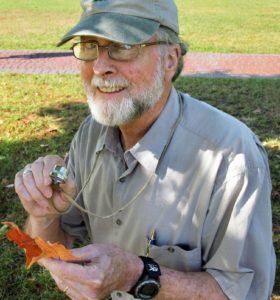By: Abby Bezrutczyk
In order to make informed decisions about invasive species management in New York State, the Invasive Species Council turns to people like Dr. George Robinson. As a professor emeritus of SUNY Albany and a member of the NY Invasive Species Advisory Committee, his research in invasive species and perspectives on citizen involvement are helping to protect our ecosystems.
Robinson transitioned from his music club business and degree in philosophy to pursue a PhD in botany at UC Davis, as he was drawn to learn more about the natural world. Today, his research has helped link invasive species to their ecosystems, as seen through his work developing methods for restoration ecology in degraded landscapes. For example, his studies on the invasive woody vine oriental bittersweet (Celastrus orbiculatus) found that maintaining a natural hydrologic regime– the natural pattern of flooding in stream systems– was able to control the spread and growth of this invasive species.
However, Robinson’s research has not just focused on invasive plants, but also the conservation of native species–through his work with Beech bark disease. While the disease has been in New York for almost a century, Robinson says that efforts to control or manage the disease have been largely ineffective, to the point that the disease has changed our forest structure. “The result is that most American beech trees here will never reach a large size, but small trees will remain abundant,” he says, adding that more research on this disease is still needed.
Robinson puts his research in action as a member of the NYS Invasive Species Advisory Committee. The committee assists the Invasive Species Council, on which Robinson also formerly held a seat, in developing invasive species classification systems and drafting proposed legislation.
One of his messages to the group is to “remember that nature is not static.” Because nature is in fact dynamic, the right management tactic can be hard to determine. “The removal of a species will not always bring an area back to the way it was before the species arrived,” He says, adding, “Sometimes, we are surprised by the species that takes its place.”
But apart from his own research, he is actively aware of the human side of invasive species management. Invasive species problems, to Robinson, need to be met with, “a lot of feet on the ground and eyes on the water.”
The best way to make people aware of invasive species problems? Get them involved in the solutions. “People who work on trail cleanups or lake cleanups gain sensitivity to the problem of trash,” he says, “and I think the outcome will be similar for those who work on weed pulls, lake surveys, and other invasive species projects.”
He’s seeing more and more people rise to the task, whether it’s through participating in citizen science, contributing data to iMapinvasives, or learning through training activities that take place each year during Invasive Species Awareness Week. “People seem to really like this work,” Robinson says, “and find it fulfilling.” He sees the future of this work in developing invasive species curricula for school children.
Invasive species management needs both research, to learn more about the species we are dealing with, and people, to apply that research in the field. With help from people like Dr. Robinson, we’re on our way to healthier ecosystems in New York State.


